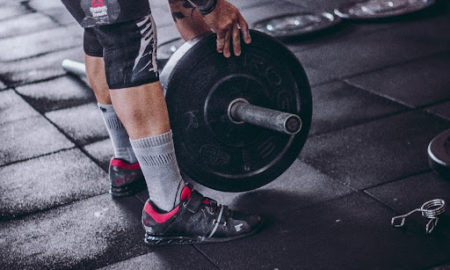Bodybuilders are constantly searching for dietary supplements that can deliver on at least some of the claims made by sport supplement companies. That’s particularly true for nitric oxide–stimulating supplements. Most products contain a form of L-arginine, the amino acid precursor of NO, in addition to other potentially synergistic ingredients, including such antioxidants as vitamin C.
Aside from simply maintaining overall health and facilitating exercise recovery, antioxidants may diminish the degradation of NO, making more of it bioavailable. While that idea may seem logical based on the independent biochemical effects of the ingredients, the research on the products’ effectiveness is sketchy.
What Is Nitric Oxide?
Nitric oxide—previously known as endothelium-derived relaxing factor, or EDRF—is synthesized in the body from L-arginine and oxygen by a family of enzymes known as nitric oxide synthases: endothelial-derived nitric oxide synthase, inducible nitric oxide synthase and neuronal nitric oxide synthase.1 It is a gaseous compound that acts as an important molecular signaling agent in the body.
Nitric oxide’s effects include a decrease in platelet and leukocyte adhesion, as well as a decrease in the proliferation of smooth muscle cells. Those effects are important in relation to decreasing clot and lesion formation in blood vessels, which may be associated with heart attack and stroke. Nitric oxide may also be involved in glucose and fatty acid oxidation,2 as well as in the stimulation of satellite cells3—which may be related to muscle tissue hypertrophy.4 Perhaps the most studied effect of NO is the way it facilitates vasodilation.
Because blood flow and the “pump” are so important to bodybuilders, supplement companies have focused heavily on NO-stimulating products over the past several years. The logic is that if a supplement can cause a measurable increase in NO, then that should lead to enhanced blood flow and enhanced oxygen and nutrient delivery during and following exercise, muscle hypertrophy and, of course, better sex.
Lifestyle Factors, Pharmaceuticals, Dietary Supplements and Nitric Oxide
Forget the sport supplement hype for a minute and understand that both acute5,6,7,8 and chronic9,10,11 exercise can increase NO—without any pills, capsules, powders or additional money spent. If you’re looking for an increase in NO above and beyond what’s been observed with exercise, however, the scientific literature has reported several effective options. They include nitrates, administered via skin patch or under the tongue, and propionyl-L-carnitine and L-arginine, which are administered intravenously. In most cases the drugs are used to treat conditions associated with impairments in blood flow, often involving various forms of cardiovascular disease.
High doses of intravenous L-arginine—10 to 30 grams—do indeed stimulate blood flow. Unfortunately, oral intake of L-arginine at dosages of 10 to 20 grams doesn’t have the same effect, as several studies have demonstrated.12,13 Moreover, an oral dosage of only 10 grams per day of L-arginine has been noted to result in gastric distress.14
An alternative is glycine propionyl-L-carnitine. We’ve been studying the effects of GPLC in our lab since 2005.
Introducing Glycine Propionyl-L-Carnitine
Glycine propionyl-L-carnitine, or GPLC, is a molecular-bonded form of propionyl-L-carnitine and the amino acid glycine. We have demonstrated an increase in blood levels of NOx, a surrogate marker of NO, with oral GPLC intake of 4.5 grams a day.15 Our findings agree with recent work in which investigators demonstrated an increase in blood NOx in subjects who received six grams per day of propionyl-L-carnitine intravenously.16
In our first study with GPLC previously sedentary men and women were assigned to supervised aerobic exercise with GPLC treatment or a placebo for eight weeks.17 It was a double-blind design—neither subjects nor investigators were aware of who got which substance. We noted a significant increase in resting levels of blood NOx for the subjects who got GPLC compared to those who got the placebo. Those who received GPLC also had lower lipid peroxidation, a measure of free-radical-mediated oxidation of lipids. That’s important, as increased free-radical production is associated with impaired NO bioavailability. In addition, excess free-radical production may be associated with impaired contractile function, reductions in muscle force output and greater fatigue rates in isolated skeletal muscle.18
Overtraining has also been linked to decreased presence of antioxidants in the blood.19 Considering the training regimens of many bodybuilders, adequate antioxidant protection appears of great importance. That’s particularly true considering that excessive free-radical production leads to poor health and a variety of diseases.20 Therefore, antioxidant supplementation may be helpful.
You need free radicals in low amounts for important physiological functions, such as cell signaling, immune response and apoptosis, the regular disintegration of used-up cells.21 So total elimination of free radicals—assuming it was possible—wouldn’t be desirable. Rather, an appropriate balance between free-radical production and antioxidant protection is the goal. In those who require additional antioxidant protection, a dietary ingredient such as GPLC may prove helpful.
Our second double-blind study involving GPLC was with resistance-trained men who were given GPLC or a placebo for four weeks each, with a two-week washout period between phases.15 Resting blood samples were obtained at the end of each four-week phase, and blood was drawn following isometric forearm exercise. Those getting GPLC had more NOx in their blood than those who got the placebo, a finding that may have implications related to enhanced blood flow during acute bouts of exercise.
More Research Needed
While those results are interesting, we have no evidence at this time that the increase in NOx will be associated with enhanced blood flow—we did not include that measure in our designs. A soon-to-be-published study, however, indicates promising effects on exercise performance associated with GPLC supplementation. Of course, additional questions related to the impact of GPLC on muscle recovery remain to be answered. Clearly, more work needs to be done. It may be something to keep your eyes on during the coming months, as other studies are now being completed, are under way or are being planned. Stay tuned
Editor’s note: Richard J. Bloomer, Ph.D., and his team have been studying the effects of GPLC since 2005 with the support of Sigma-tau Health Science, the manufacturer of the product. They encourage readers to examine the material presented, as well as the reference data provided, at www.pubmed.gov.
References
1 Collier, J., and Vallance, P. (1991). Physiological importance of nitric oxide. BMJ. 32:1289-1290.
2 Jobgen, W.S., et al. (2006). Regulatory role for the arginine-nitric oxide pathway in metabolism of energy substrates. J Nutr Biochem. 9:571-588.
3 Anderson, J.E. (2000). A role for nitric oxide in muscle repair: Nitric oxide-mediated activation of muscle satellite cells. Mol Biol Cell. 11:1859-1874.
4 Salanova, M., et al. (2008). Molecular biomarkers monitoring human skeletal muscle fibres and microvasculature following long-term bed rest with and without countermeasures. J Anat. 212(3):306-18.
5 Bode-Boger, S.M., et al. (1994). Exercise increases systemic nitric oxide production in men. J Cardiovasc Risk. 1:173-178.
6 Clarkson, P., et al. (1999). Exercise training enhances endothelial function in young men. J Am Coll Cardiol. 33:1379-1385.
7 Gilligan, D.M., et al. (1994). Contribution of endothelium-derived nitric oxide to exercise-induced vasodilation. Circulation. 90:2853-2858.
8 Hickner, R.C., et al. (1997). Role of nitric oxide in skeletal muscle blood flow at rest and during dynamic exercise in humans. Am J Physiol. 273(1 Pt 2):H405-410.
9 Edwards, D.G., et al. (2004). Effect of exercise training on endothelial function in men with coronary artery disease. Am J Cardiol. 93(5):617-20.
10 Poveda, J.J., et al. (1997). Contribution of nitric oxide to exercise-induced changes in healthy volunteers: Effects of acute exercise and long-term physical training. Eur J Clin Invest. 27(11):967-971.
11 Tordi, N., et al. (2006). Effects of resuming endurance training on arterial stiffness and nitric oxide production during exercise in elite cyclists. Appl Physiol Nutr Metab. 31(3):244-249.
12 Adams, M.R., et al. (1995). Oral arginine inhibits platelet aggregation but does not enhance endothelium-dependent dilation in healthy young men. J Amer Col Cardiology. 26(4):1054-61.
13 Chin-Dusting, J.P., et al. (1996). Effects of in vivo and in vitro L-arginine supplementation on healthy human vessels. J Cardiovasc Pharmacol. 28(1):158-166.
14 Robinson, T.M., Sewell, D.A., and Greenhaff, P.L. (2003). L-arginine ingestion after rest and exercise: Effects on glucose disposal. Med Sci Sports Exerc. 35:1309-1315.
15 Bloomer, R.J., et al. (2007). Glycine propionyl-L-carnitine increases plasma nitrate/nitrite in resistance trained men. J Inter Soc Sports Nutr. 4:22, Epub Dec 3.
16 Loffredo, L., et al. (2007). Oxidative-stress-mediated arterial dysfunction in patients with peripheral arterial disease. Eur Heart J. 28(5):608-612.
17 Bloomer, R.J., et al. (2008). Glycine propionyl-L-carnitine modulates lipid peroxidation and nitric oxide in human subjects. Int J Vit Nutr Res. In press.
18 Reid, M.B. (2001). Nitric oxide, reactive oxygen species, and skeletal muscle contraction. Med Sci Sports Exerc. 33(3):371-376.
19 Palazzetti, S., et al. (2003). Overloaded training increases exercise-induced oxidative stress and damage. Can J Appl Physiol. 28(4):588-604.
20 Dhalla, N.S., et al. (2000). Role of oxidative stress in cardiovascular diseases. J Hypertens. 18:655-673.
21 Vollaard, N.B., et al. (2005). Exercise-induced oxidative stress: Myths, realities and physiological relevance. Sports Med. 35:1045-1062. IM
















You must be logged in to post a comment Login